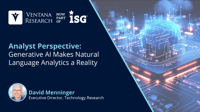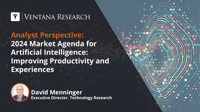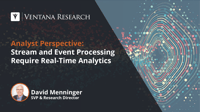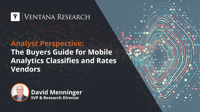We’ve been saying for years that natural language processing (NLP) and natural language analytics would greatly expand access to analytics. However, prior to the explosion of generative AI (GenAI), software providers had struggled to bring robust natural language capabilities to market. It required considerable manual effort. Many analytics providers had introduced natural language capabilities, but they didn’t really resonate with enterprise requirements. They required significant effort to...
Read More
Topics:
Business Intelligence,
Artificial intelligence,
natural language processing,
AI & Machine Learning,
Analytics & Data,
GenAI
Ventana Research recently announced its 2024 Market Agenda for Artificial Intelligence, continuing the guidance we have offered for two decades to help enterprises derive optimal value from technology and improve business outcomes.
Read More
Topics:
Artificial intelligence,
natural language processing,
Generative AI,
Deep Learning,
Model Building and Large Language Models,
Computer Vision
Alteryx was founded in 1997 and initially focused on analyzing demographic and geographically organized data. In 2006, the company released its eponymous product that established its direction for what the product is today. In 2017, it went public in an IPO on the NYSE. At the time of the IPO, Alteryx was focusing much of its marketing efforts on the data preparation market, particularly to support Tableau. Throughout this time though, Alteryx offered much more than data preparation. As a...
Read More
Topics:
Analytics,
Business Intelligence,
data operations,
AI & Machine Learning,
Analytics & Data,
Analytic Operations
In my past perspectives, I’ve written about the evolution from data at rest to data in motion and the fact that you can’t rely on dashboards for real-time analytics. Organizations are becoming more and more event-driven and operating based on streaming data. As well, analytics are becoming more and more intertwined with operations. More than one-fifth of organizations (22%) describe their analytics workloads as real time in our Data and Analytics Benchmark Research and nearly half (47%) of...
Read More
Topics:
Analytics,
Business Intelligence,
Data,
Digital Technology,
Streaming Analytics,
Analytics & Data,
Streaming Data & Events
I am happy to share insights gleaned from our latest Buyers Guide, an assessment of how well vendors’ offerings meet buyers’ requirements. The Ventana Research 2023 Mobile Analytics Buyers Guide is the distillation of a year of market and product research by Ventana Research. Drawing on our Benchmark Research, we apply a structured methodology built on evaluation categories that reflect the real-world criteria incorporated in a request for proposal to Analytics vendors supporting the spectrum...
Read More
Topics:
Analytics,
Analytics & Data,
Mobile Analytics
The 2023 Ventana Research Buyers Guide for Mobile Analytics research enables me to provide observations about how the market has advanced.
Read More
Topics:
Analytics,
Analytics & Data,
Mobile Analytics
I am happy to share insights gleaned from our latest Buyers Guide, an assessment of how well vendors’ offerings meet buyers’ requirements. The Ventana Research 2023 Collaborative Analytics Buyers Guide is the distillation of a year of market and product research by Ventana Research. Drawing on our Benchmark Research, we apply a structured methodology built on evaluation categories that reflect the real-world criteria incorporated in a request for proposal to Analytics vendors supporting the...
Read More
Topics:
Analytics,
Analytics & Data,
Collaborative Analytics
The 2023 Ventana Research Buyers Guide for Collaborative Analytics research enables me to provide observations about how the market has advanced.
Read More
Topics:
Analytics,
Analytics & Data,
Collaborative Analytics
I am happy to share insights gleaned from our latest Buyers Guide, an assessment of how well vendors’ offerings meet buyers’ requirements. The Ventana Research 2023 Embedded Analytics Buyers Guide is the distillation of a year of market and product research by Ventana Research. Drawing on our Benchmark Research, we apply a structured methodology built on evaluation categories that reflect the real-world criteria incorporated in a request for proposal to Analytics vendors supporting the spectrum...
Read More
Topics:
embedded analytics,
Analytics
The 2023 Ventana Research Buyers Guide for Embedded Analytics research enables me to provide observations about how the market has advanced.
Read More
Topics:
embedded analytics,
Analytics



















